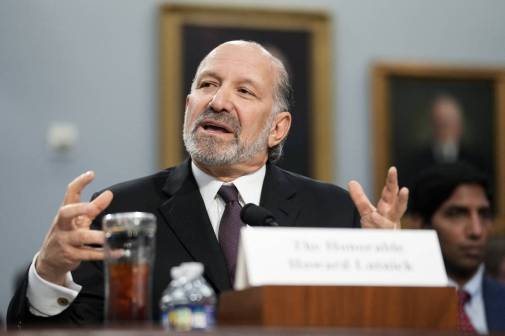NTIA unveils draft guidance for states weighing FirstNet options

State officials are about to get their first glimpse of details that will help them to decide whether to opt in or out of a nationwide broadband network for first responders.
The National Telecommunications and Information Administration released a draft version of guidelines Tuesday that states will have to follow if they want to opt out of a national plan to create a dedicated public safety network for first responders.
The NTIA notice and request for comment also calls on states to provide input on steps the agency laid out that would let states to construct their own radio access networks instead of relying on the First Responder Network Authority, also known as FirstNet.
While federal law calls for FirstNet to take the lead in building out a “National Public Safety Broadband Network” — and the group is currently evaluating proposals from companies hoping to help with that effort — the statute does allow each state to construct the cell site equipment, antennas and backhaul equipment to form a radio access network (also known as a RAN) that can work with FirstNet’s core system. The NTIA’s new guidance is aimed at laying out how regulators would evaluate a state’s proposal to take on that responsibility, lending some clarity to a previously murky process.
Specifically, the agency’s analysts write that states will have to submit their opt out plans to both the NTIA and the Federal Communications Commission before they can proceed.
Once FirstNet awards a contract for the network to a private provider (a process board members hope to wrap up by the end of the year) and delivers a timeline for the network’s construction in each state, each governor will have 90 days to tell FirstNet, the NTIA and the FCC that they plan to opt out. Then, they’ll have 180 days to “develop and complete requests for proposals for the construction, maintenance and operation” of the radio access network, the NTIA wrote.
With a concrete roadmap in hand, the state then has to submit those documents to the FCC to let regulators decide if it meets “minimum technical interoperability requirements” with the rest of the network FirstNet will build.
The FCC will have the power to reject a state plan outright, letting FirstNet take over build-out efforts if it doesn’t approve. But if the commission gives a state’s plan the green light, states will have 60 days to submit the proposal to the NTIA after the FCC signs off on it, though the NTIA notes that’s only a “tentative” deadline.
Regulators will then evaluate the proposal based on five key categories outlined in the federal statute that created FirstNet.
Primarily, it plans to investigate whether a state “has the technical capabilities to operate and the funding to support” the network, and if it “has the ability to maintain ongoing RAN interoperability” with FirstNet’s core network. Additionally, regulators will weigh if “the state has the ability to complete the RAN buildout within specified comparable timelines specific to the state,” and “the ability to provide RAN security, coverage and quality of service comparable to that of” what FirstNet can provide. Finally, they’ll consider each proposal’s “cost effectiveness.”
The NTIA writes that it will issue a “federal funding opportunity notice” in the near future to lay out “more specific, quantifiable and finalized criteria” for how states can meet those standards, but in the meantime, it does lay out some factors it plans to consider as part of the process.
The agency’s analysts suggest that any state effort to build a RAN should match the technical standards adopted by FirstNet as it builds its own core network, as they feel that “applying the network policies uniformly to all parts of the RAN helps ensure the [network] will function uniformly and in a manner that best serves public safety.”
The NTIA is also hoping to see states “identify the proposed management capabilities and organizational structure of its RAN project team,” with details on “planned staff size.” Crucially, the regulators will also need detailed descriptions of how the state hopes to pay for the RAN, including any details on grants it plans to use or potential partnerships with private companies for the effort, noting that the “NTIA may require surety bonds to ensure RAN construction completion in the event of default by the state’s RFP partner.”
Additionally, regulators want to see timelines for the network’s completion that are “of the same number, nature, and type as those presented to the state by FirstNet in its proposed state plan.” The NTIA also warns that any state hoping to build a network that “does not leverage existing infrastructure and/or a public-private partnership and deploys a network solely consisting of new components is not likely to demonstrate cost effectiveness.”
[Read more: Lawmakers worry FirstNet won’t cover more rural areas]
“In determining cost-effectiveness, NTIA may assess areas, including but not limited to, the proposed federal and state partner share of the RAN cost; the value, use, and revenue return of spectrum and other assets; and overall financial value of the proposed plan,” the regulators wrote.
Finally, as they weigh the quality of a network’s coverage, they stress that they’ll put a focus on its performance in rural areas, writing that “any state with significant rural areas should include substantial rural coverage milestones as part of its overall demonstration.”
Should the NTIA give a state passing marks on all those criteria, they’ll grant it the authority to lease spectrum from FirstNet to let the project proceed. The state will also be able to apply for grant funding from the NTIA to help build the network, though it won’t have to do so.
Questions about the cost burdens of supporting FirstNet, and how a state might go about opting out of FirstNet’s RAN efforts, have been a recurring concern among state leaders even as support for a dedicated system for first responders gained momentum.
Last month, National Governors Association analysts testified before a Senate subcommittee about their concerns about the process, while the National Association of State Chief Information Officers raised the issue with FirstNet board members during a lobbying trip to Washington, D.C. in May.
However, many of these standards are still up for discussion, which is why the NTIA plans to accept comment on the guidelines until Aug. 18. The FCC will also soon issue its own guidance on the issue, according to a FirstNet blog post earlier this month.






